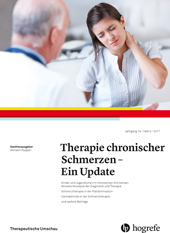Cannabinoide in der Schmerztherapie
Abstract
Zusammenfassung. In den letzten Jahren wurden zahlreiche wissenschaftliche Arbeiten zum Gebrauch von Cannabisextrakten und synthetischen Cannabinoiden in der Schmerztherapie publiziert. Gleichzeitig haben Berichte in Populärmedien dazu geführt, dass diese Medikamente durch Patienten vermehrt nachgefragt werden. In der Schweiz wurde die Möglichkeit, diese Substanzen zu verschreiben durch Gesetzesänderungen zwar erleichtert, für die meisten Indikationen braucht es aber nach wie vor eine Ausnahmegenehmigung des Bundes. Δ9-trans-Tetrahydrocannabinol (THC) und Cannabidiol (CBD) sind die Hauptwirkstoffe dieser Medikamente. Diese sind zurzeit nicht kassenpflichtig und im Vergleich zu Standardtherapien deutlich teurer. Randomisierte kontrollierte Studien zeigen zum Teil eine gute Wirksamkeit gegen Spastik bei Multipler Sklerose und nach Rückenmarksverletzungen sowie bei Schmerzen von neuropathischem Charakter und Tumorschmerzen. Kürzlich durchgeführte grosse Metaanalysen erbrachten weniger klare Resultate. Werden die Kontraindikationen berücksichtigt, sind schwere psychiatrische Nebenwirkungen im Vergleich zu Placebo nicht häufiger. Als typische Nebenwirkung der psychotropen Wirkung von THC treten Müdigkeit und Schwindel auf. Da Standardtherapien oftmals ein deutlich besseres Wirkungs-/Nebenwirkungsverhältnis haben, sollten Cannabinoide nicht als erste Medikation eingesetzt werden. Bei ausgewählten Patienten können Cannabismedikamente bei nicht ausreichendem Effekt von Erst- und Zweitlinientherapien in Betracht gezogen werden. Neue Erkenntnisse in der Grundlagenforschung zum Endocannabinoid-System lassen in der Zukunft auf spezifischere Cannabinoid-Medikamente mit besserer Wirkung hoffen. Allfällige Folgen einer langjährigen Cannabismedikation lassen sich aktuell mangels Studien nicht abschätzen.
Abstract. Restrictive laws have been revised in recent years to allow the prescription of cannabis plant extracts and synthetic cannabinoids. Therefore so called medical marijuana and cannabinoids are getting more and more attention and acceptance in pain therapy and general physicians are often asked for this new treatment by patients who suffer from chronic pain. With the growing number of scientific work the indications for potential beneficial use of medical cannabinoids are increasing. In Switzerland the prescription of marijuana and cannabinoids still needs a special permission from the department of health (BAG). It is not mandatory for health insurance companies to reimburse the drugs. More than 100 different cannabinoids are known nowadays. Of those the psychotropic Δ9-trans-Tetrahydrocannabinol (THC) and the non psychotropic cannabidiol (CBD) are the best characterized substances. Some randomized controlled trials have shown a good efficacy against spasticity in multiple sclerosis and after spinal cord injuries. There are positive studies for neuropathic and cancer pain as well. Recent meta-analysis gave less convincing results. The safety of cannabinoids is considered good. Severe psychiatric side effects are very rare if contra-indications are respected. Fatigue, dizziness and dry mouth are common transient side effects that often lead to drop out of therapy. Standard treatments have better benefit to risk ratios. Medical cannabinoids should therefore not be used as first line treatment in chronic pain. In contrast, if standard treatment has failed for these conditions, medical cannabinoids can be considered. With more research in basic science and better understanding of the endocannabinoid system there is hope for new and more specific drugs in the future. At the moment the long-term effects of chronic cannabinoid treatment are not known.



